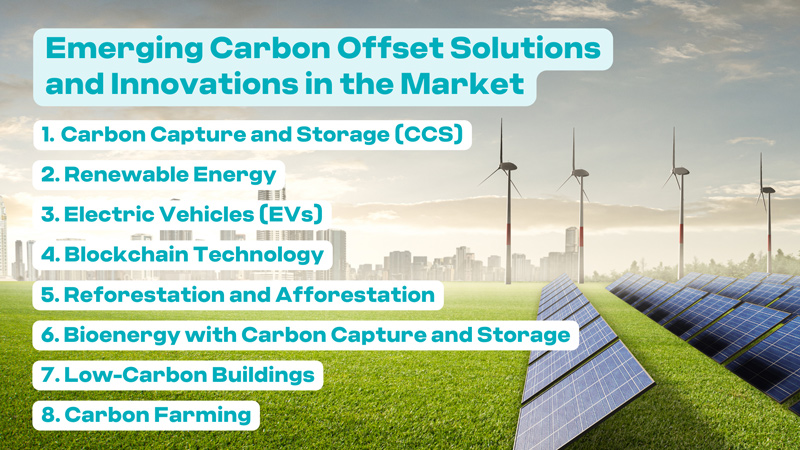For people and businesses looking to reduce their carbon footprint and minimize their contribution to man-made climate change, carbon offsetting is a rapidly growing area of research and development. Although carbon offsetting has been around for a while, recent developments in technology and innovation are opening up new doors to combat global warming. In this article we will discuss the future of carbon offsetting, listing some of the most fascinating and innovative new innovations in the space.
What is Carbon Offsetting?
Carbon offsetting is a practice aimed at reducing carbon emissions. It works on the principle that every time we travel or use energy, carbon dioxide (CO2) is released into the atmosphere, contributing to global warming. To offset this, funds can be allocated towards projects that reduce or eliminate the amount of CO2 that is produced elsewhere. These projects can include reforestation, renewable energy initiatives, and other carbon reduction activities that aim to offset the carbon footprint of individuals or businesses.
Popularity of carbon offsetting projects has grown significantly in recent years due to the increase in awareness about the devastating long-term effects of climate change. By offsetting their carbon footprint, individuals and businesses can make a tangible contribution towards reducing greenhouse gas emissions and supporting sustainable development. It is important to note that carbon offsetting should not be viewed as a substitute for reducing emissions at the source, but rather as a complementary strategy that can help us achieve a net-zero future.
Carbon offsetting has become an increasingly important part of corporate social responsibility (CSR) initiatives, with many companies committing to becoming carbon-neutral or carbon-negative. The concept of carbon neutrality involves achieving a balance between the amount of CO2 emissions released and the amount removed from the atmosphere through offsetting activities. This requires a holistic approach that incorporates energy-efficient practices, renewable energy investments, and other sustainability measures that reduce carbon emissions. By committing to carbon neutrality, companies can not only reduce their environmental impact but also enhance their reputation, attract environmentally conscious customers, and potentially save costs by reducing their energy consumption.
What are some of the Emerging Carbon Offset Solutions and Innovations in the Market?

1. Carbon Capture and Storage (CCS)
Carbon Capture and Storage (CCS) is a technology that has been developed to capture CO2 emissions from industrial activities such as power plants, cement factories, and steel mills. The captured CO2 is then compressed and transported to a storage facility, where it is stored underground in depleted oil and gas reservoirs or saline aquifers. This technology is an important part of the solution to climate change because it has the potential to reduce greenhouse gas emissions by up to 90%.
According to the International Energy Agency (IEA), CCS is critical to achieving the goals of the Paris Agreement and limiting global warming to below 2°C. In fact, the IEA has projected that without the widespread deployment of CCS, the cost of achieving the Paris Agreement goals could increase by as much as 138%. In addition, a recent study by the Global CCS Institute found that CCS has the potential to create millions of jobs worldwide and generate significant economic benefits.
Despite its potential, CCS has been slow to gain traction due to its high costs and lack of regulatory incentives. However, with the increasing urgency of climate change, governments and businesses around the world are beginning to recognize the importance of CCS and are investing in its development. For example, the UK government recently announced a £171 million investment in CCS projects, and the Norwegian government is supporting the development of a CCS value chain. As the costs of CCS continue to decrease, it is likely that it will become a more widespread and viable option for reducing CO2 emissions from industrial activities.
2. Renewable Energy
Renewable energy sources such as solar, wind, and hydropower have become increasingly cost-effective and accessible over the past decade. The cost of solar and wind power has dropped significantly, making them more competitive with traditional fossil fuel sources. According to a report by the International Renewable Energy Agency (IRENA), the cost of solar and wind power is now lower than the cost of new coal-fired power plants in most parts of the world. In addition, the global renewable energy sector has created over 11 million jobs, with the potential to create millions more in the coming years.
Renewable energy not only helps to reduce CO2 emissions, but also provides significant economic benefits. For example, a study by the European Commission found that a transition to renewable energy could lead to an increase in GDP of up to 1% by 2030, as well as the creation of up to 900,000 new jobs in the EU alone. In addition, a report by the United Nations Environment Programme (UNEP) found that the global transition to renewable energy could lead to savings of up to $160 trillion by 2050, by avoiding the costs of climate change and reducing the health impacts of air pollution.
3. Electric Vehicles (EVs)
Electric vehicles (EVs) are a rapidly growing technology that are becoming increasingly popular as prices come down and technology advances. According to the International Energy Agency (IEA), nearly 10% of global car sales were electric in 2021, four times the market share in 2019, and triple the amount in 2018. This brought the total number of electric cars on the world’s roads to about 16.5 million. This growth is expected to continue, with the IEA predicting that there could be as many as 145 million electric cars on the road by 2030. As EVs emit much fewer greenhouse gases than conventional gasoline-powered cars, they are a crucial component in the transition to a more sustainable future.
In addition to their environmental benefits, EVs also have the potential to significantly reduce the cost of vehicle ownership. A report by Bloomberg New Energy Finance (BNEF) found that electric cars are expected to be cheaper to produce than traditional gas-powered vehicles by 2027, due to falling battery costs and increasing production volumes. This could lead to significant savings for both individual consumers and businesses. Furthermore, the growth of the electric vehicle industry is creating new opportunities for innovation and investment, with companies developing new charging technologies, battery technologies, and software to improve the efficiency and performance of EVs.
4. Blockchain Technology
Blockchain technology is a distributed, transparent, and secure database that provides an efficient means of recording and tracking transactions. It has the potential to revolutionize carbon offsetting by enabling transparency and accountability in carbon credit trading. Blockchain can be used to create a secure and tamper-proof ledger that tracks the emissions reductions achieved by carbon offset projects, making it easier to verify their legitimacy.
By using blockchain technology, companies can easily track the carbon offset projects they have invested in, ensuring that the funds are being used for their intended purposes. Moreover, blockchain can enable the creation of new carbon offset projects by facilitating the trading of carbon credits on a secure and transparent platform. This can provide a new source of revenue for companies and encourage the growth of the carbon offset market.
According to a study by the World Economic Forum, blockchain technology has the potential to reduce global greenhouse gas emissions by up to 15%. By increasing transparency and accountability in the carbon offset market, blockchain can incentivize more companies to participate in carbon offsetting, contributing to a more sustainable future.
5. Reforestation and Afforestation
Reforestation and afforestation initiatives are gaining popularity as a carbon offsetting solution, and for good reason. Studies have shown that forests absorb and store massive amounts of carbon, helping to mitigate climate change. In fact, one study found that global reforestation could remove two-thirds of the carbon emissions that have been released into the atmosphere since the Industrial Revolution.
Not only does reforestation and afforestation help to absorb CO2, but they also have numerous other benefits. Forests play a critical role in regulating the Earth’s climate, water, and nutrient cycles, which are all essential components of a healthy ecosystem. Additionally, forests provide habitat for countless species of plants and animals, and can be used for sustainable timber production and recreation. By supporting reforestation and afforestation initiatives, businesses can make a significant positive impact on the environment while also supporting the health of local communities and economies.
6. Bioenergy with Carbon Capture and Storage (BECCS)
Bioenergy with Carbon Capture and Storage (BECCS) is a promising innovation that offers a unique approach to combating climate change. This technology aims to capture CO2 emissions generated by biomass as a fuel source, which can then be stored underground. A study by the International Energy Agency (IEA) suggests that BECCS could reduce CO2 emissions by 3-5 gigatons per year, equivalent to the annual emissions of the European Union.
BECCS technology has the potential to be carbon negative, which means it can remove more CO2 from the atmosphere than it produces. This could be a game-changer in the fight against climate change, as it could potentially help reverse the current trend of rising CO2 levels. It is worth noting that the implementation of BECCS technology requires careful consideration of environmental and social factors, as well as technological feasibility and cost-effectiveness. However, if implemented correctly, BECCS could be an effective and sustainable solution to reduce CO2 emissions and help mitigate climate change.
7. Low-Carbon Buildings
Low-carbon buildings represent a significant innovation in carbon offsetting, as they are a key means of reducing emissions from the built environment. According to the UK Green Building Council, buildings are responsible for around 40% of global energy consumption and 33% of greenhouse gas emissions, highlighting the importance of this technology in the fight against climate change.
Low-carbon buildings can help reduce emissions by utilizing energy-efficient technologies and environmentally friendly building materials, such as recycled steel and concrete, reclaimed wood, and low-VOC paints. They can also be designed to incorporate renewable energy sources, such as solar panels, wind turbines, and geothermal heating and cooling systems. Additionally, low-carbon buildings can be constructed to be more resilient to climate change impacts, such as flooding and extreme weather events, by using innovative techniques such as green roofs and permeable pavement.
8. Carbon Farming
Carbon farming is an innovative technique that can be used to reduce atmospheric carbon levels by capturing and storing carbon in soil and vegetation. According to a study by the USDA Natural Resources Conservation Service, carbon farming can sequester up to 25% of current US greenhouse gas emissions annually, making it a crucial strategy in the fight against climate change. By implementing practices such as no-till agriculture, planting cover crops, and restoring wetlands, businesses can participate in this effective carbon offsetting approach and simultaneously improve soil health and increase food security.
Recent advances in carbon farming have shown that it is not only an effective means of offsetting carbon emissions but can also offer a variety of other benefits. A study by the Climate Policy Initiative found that carbon farming practices can help to mitigate the risks of drought and other climate-related threats while also promoting biodiversity and supporting rural economies. As such, carbon farming can be a powerful tool for businesses looking to integrate environmentally conscious practices into their operations while also contributing to the overall health of the planet.
Offset your Emissions Today with our Portfolio of Verified Projects
Our initiatives have received global certification from the Gold Standard Verified Emission Reductions (VER) and Verified Carbon Standard (VCS), which confirm that they adhere to the BSI’s PAS 2060 carbon neutrality standard and the Quality Assurance Standard for Carbon Offsetting. Our initiatives are completely traceable and have been shown to reduce atmospheric carbon emissions.




